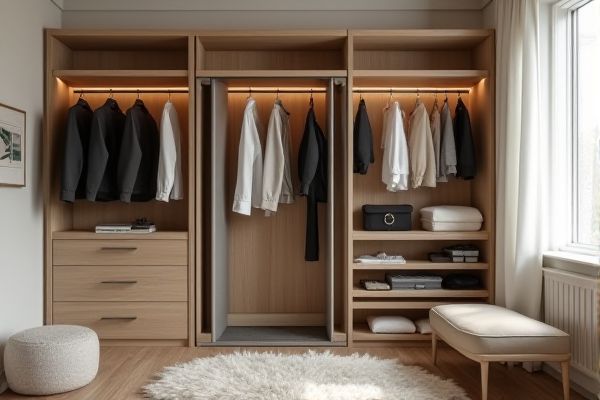
Closet garment lifts and closet elevators both maximize vertical wardrobe space by allowing easy access to hanging clothes, but garment lifts typically feature manual pulley systems while closet elevators often offer motorized or automated lifting mechanisms. Explore the rest of the article to determine which solution best suits your closet needs and lifestyle.
Table of Comparison
| Feature | Closet Garment Lift | Closet Elevator |
|---|---|---|
| Function | Lifts garments vertically within reach | Raises and lowers entire closet sections |
| Capacity | Holds multiple garments on a single rod | Supports heavier loads including shelves and clothes |
| Installation | Wall or cabinet mounted | Freestanding or built-in mechanism |
| Operation | Manual or motorized lift | Motorized lift with controls |
| Space Efficiency | Optimizes hanging space at high levels | Maximizes vertical storage by shifting entire units |
| Price Range | $150 - $600 | $1000 - $4000+ |
| Ideal Use | Small to medium closets | Large closets or custom closet systems |
| Installation Complexity | Simple to moderate | Complex, may require professional installation |
Closet Garment Lift vs Closet Elevator: Key Differences
Closet garment lifts typically feature a manual or spring-assisted mechanism that lowers and raises clothing rods vertically for easy access, ideal for maximizing vertical closet space. Closet elevators often refer to motorized systems with automated lifting and lowering functions, offering hands-free convenience and advanced control options. The key differences lie in operation methods, price points, and installation complexity, with garment lifts favoring simplicity and affordability while elevators provide enhanced automation and accessibility.
Space Efficiency: Garment Lifts Compared to Closet Elevators
Closet garment lifts maximize vertical storage space by allowing clothing to be lowered and raised within a cabinet, making them ideal for compact areas. Closet elevators provide similar functionality but often incorporate motorized systems that require additional clearance, slightly reducing overall space efficiency. Garment lifts generally offer a more streamlined solution for optimizing closet space without significant modification.
Installation Requirements for Closet Garment Lifts and Elevators
Closet garment lifts typically require a sturdy overhead support and precise mounting brackets to ensure smooth vertical movement within the closet frame. Closet elevators demand reinforced wall anchors and often a deeper closet depth to accommodate the lifting mechanism and added weight capacity. Both systems benefit from professional installation to guarantee safety and optimal performance in compact or custom closet spaces.
Cost Comparison: Closet Garment Lift vs Closet Elevator
Closet garment lifts typically cost between $150 and $500, making them a budget-friendly option for optimizing vertical closet space. Closet elevators, designed with more complex mechanical systems and enhanced durability, often range from $500 to $1,200, reflecting their premium features and higher installation requirements. Choosing between the two depends on budget constraints and desired functionality for efficient garment storage.
Accessibility and User Convenience
Closet garment lifts offer enhanced accessibility by allowing users to lower clothes to a comfortable height, making it easier to reach items stored in high cabinets. Closet elevators provide a similar function but typically feature motorized mechanisms for effortless adjustment, improving user convenience for individuals with limited mobility. Both options maximize storage efficiency while reducing physical strain during wardrobe organization.
Capacity and Weight Limits
Closet garment lifts typically support weight capacities ranging from 25 to 40 pounds, making them ideal for lighter clothing items like shirts and blouses. Closet elevators, on the other hand, are designed to handle heavier loads, often exceeding 50 pounds, providing a robust solution for bulkier garments such as coats and suits. Understanding the capacity and weight limits will help you choose the right system to ensure durability and ease of use in your closet.
Design Options and Customization
Closet garment lifts offer versatile design options such as adjustable rods, multiple height settings, and sleek finishes that blend seamlessly with your existing cabinetry. Closet elevators provide customization through motorized controls, varied extension lengths, and integration with smart home systems for effortless accessibility. Your choice depends on whether you prioritize manual adjustment flexibility or automated convenience in your closet organization.
Maintenance and Longevity
Closet garment lifts require regular lubrication and careful handling to maintain smooth operation and prevent wear on moving parts, ensuring longevity. Closet elevators, designed with more robust mechanisms and often enclosed systems, typically demand less frequent maintenance and offer enhanced durability over time. You can extend the lifespan of either system by performing routine inspections and addressing any mechanical issues promptly.
Ideal Use Cases for Garment Lifts and Closet Elevators
Closet garment lifts are ideal for maximizing vertical closet space by easily lowering clothes to your reach, perfect for tall wardrobes often found in bedrooms or walk-in closets. Closet elevators are better suited for storing heavier items or multiple garments, offering smooth mechanical lifting for enhancing accessibility in compact or multi-level closets. Your choice depends on the weight capacity and frequency of use, with garment lifts focusing on convenience and elevators on durability and load handling.
Choosing the Best Solution for Your Closet Needs
Closet garment lifts offer a space-saving solution by allowing easy access to hanging clothes through a pulley system, ideal for maximizing vertical storage in small or tall closets. Closet elevators provide motorized, automated lifting platforms that enhance convenience and accessibility, particularly beneficial for users seeking hands-free operation and advanced technology integration. Selecting the best solution depends on closet dimensions, user mobility, desired level of automation, and budget considerations to optimize functionality and comfort.
 homyna.com
homyna.com